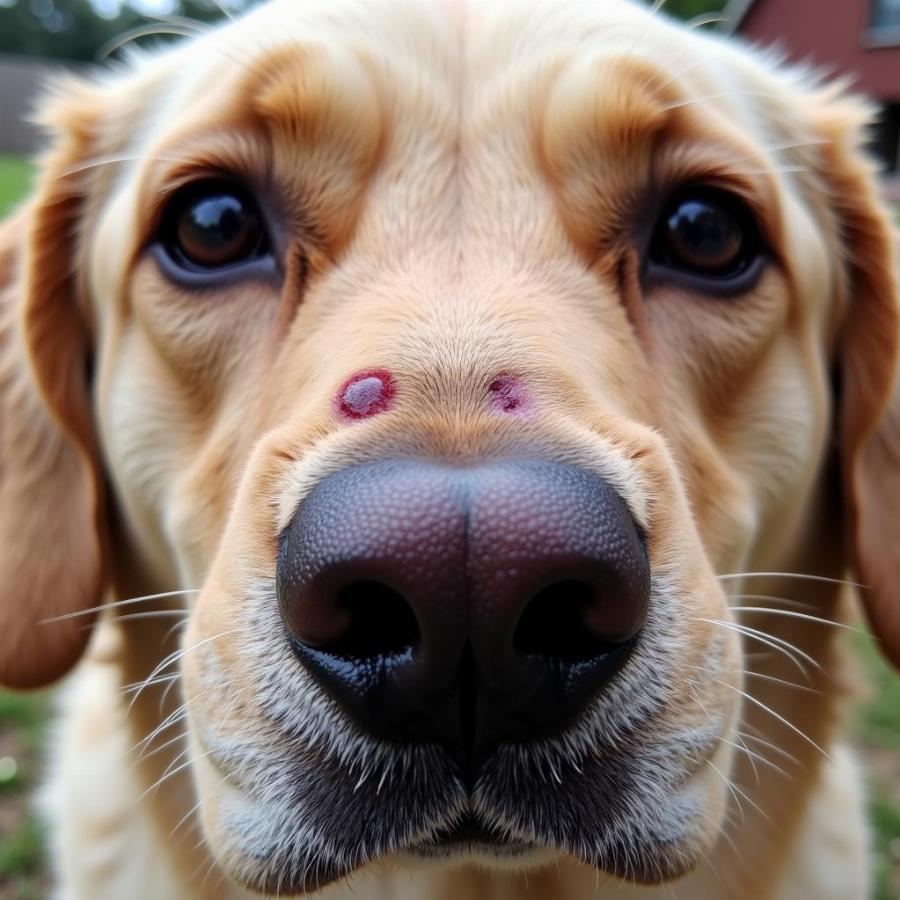Mange. The word itself can evoke images of uncomfortable, itchy dogs and worried owners. If you’re searching for “pictures of mange on dogs,” you’re likely concerned about your furry friend’s skin health. This article will provide you with a visual guide to different types of mange, along with information on symptoms, diagnosis, and treatment options. Understanding this common skin condition is the first step towards ensuring your dog’s comfort and well-being.
Recognizing the Telltale Signs of Mange in Dogs
Mange is a skin disease caused by microscopic mites. These tiny parasites burrow into the skin, causing intense itching, hair loss, and inflammation. While several types of mange exist, they share some common symptoms. Recognizing these signs early can make a significant difference in your dog’s recovery. Look for excessive scratching, licking, or biting at the skin, particularly around the face, ears, paws, and elbows. Hair loss, either in patches or generalized thinning, is another common indicator. The skin may appear red, inflamed, crusty, or thickened. In severe cases, secondary bacterial infections can develop, leading to unpleasant odors and further discomfort.
 Dog with Demodectic Mange
Dog with Demodectic Mange
Types of Mange: Demodectic vs. Sarcoptic
Two main types of mange affect dogs: demodectic and sarcoptic. Demodectic mange, caused by the Demodex canis mite, is not typically contagious to humans or other pets. All dogs have a small number of these mites living on their skin, but in certain situations, like a weakened immune system, the mite population can explode, causing the condition. Sarcoptic mange, also known as scabies, is highly contagious to both dogs and humans. It is caused by the Sarcoptes scabiei mite, which burrows deep into the skin, causing intense itching and irritation.
Demodectic Mange in Detail
Demodectic mange can present in localized or generalized forms. Localized demodectic mange often affects puppies and young dogs, appearing as small, circular patches of hair loss. It typically resolves on its own without treatment. Generalized demodectic mange involves more widespread hair loss and skin inflammation. It can be more challenging to treat and often requires veterinary intervention.
Sarcoptic Mange in Detail
Sarcoptic mange, unlike demodectic mange, is highly contagious. The mites spread through direct contact, and even brief exposure can lead to infestation. The intense itching associated with sarcoptic mange can significantly disrupt a dog’s quality of life. Early diagnosis and treatment are crucial to prevent the spread of the mites and alleviate the dog’s discomfort. For persistent itch relief, you might find resources on itch relief shampoo for dogs helpful.
Diagnosing Mange: Veterinary Expertise is Key
While pictures of mange on dogs can be helpful for initial identification, a definitive diagnosis requires a veterinary examination. Your veterinarian will likely perform a skin scraping to collect a sample and examine it under a microscope to identify the presence of mites. This allows for accurate diagnosis and determination of the specific type of mange, guiding appropriate treatment.
Treatment Options and Management Strategies
Treatment for mange varies depending on the type and severity of the infestation. Demodectic mange, especially the localized form, may resolve without treatment. However, generalized demodectic mange often requires medicated dips, shampoos, or oral medications. Sarcoptic mange typically requires more aggressive treatment, often involving prescription medications to kill the mites. Regular cleaning of bedding and living areas is crucial to prevent reinfestation and further spread of the mites. You can find more information on effective treatments at mange dip for dogs. Looking for images to compare your dog’s condition? You can find more pictures of the mange on dogs.
Conclusion: Taking Action for a Healthy Coat
Finding pictures of mange on dogs that resemble your dog’s skin condition can be concerning. However, armed with the right information and veterinary guidance, you can effectively manage and treat this common skin ailment. Early detection and appropriate treatment are crucial for alleviating your dog’s discomfort and restoring their healthy coat. Don’t hesitate to consult your veterinarian if you suspect your dog has mange.
FAQ: Frequently Asked Questions about Mange
- Is mange contagious to humans? Sarcoptic mange is contagious to humans. Demodectic mange is not typically contagious to humans.
- How is mange diagnosed? A veterinarian diagnoses mange by performing a skin scraping and examining it under a microscope.
- Can mange be cured? Yes, with proper veterinary care and treatment, mange can be cured.
- How long does mange treatment take? Treatment duration varies depending on the type of mange and severity, but it can take several weeks or even months.
- How can I prevent mange? Maintaining good hygiene for your dog, avoiding contact with infected animals, and regular veterinary check-ups can help prevent mange.
- What are the signs of mange in dogs? Signs include excessive scratching, hair loss, redness, inflammation, and crusting of the skin. You can see pictures of the mange on dogs for visual examples.
- What should I do if I think my dog has mange? Consult your veterinarian immediately for a proper diagnosis and treatment plan.
Further Reading
Explore other related articles on Beaut Dogs, such as dog eye conditions pictures and hair bows for dogs.
Beaut Dogs is your go-to resource for all things related to show dogs, providing reliable and in-depth information about the canine world. From breed characteristics to health care tips, we’re dedicated to helping you provide the best possible care for your beloved companion. When you need assistance, please contact us at Email: [email protected] for detailed and accurate answers from Beaut Dogs. Visit us at https://beautdogs.com.